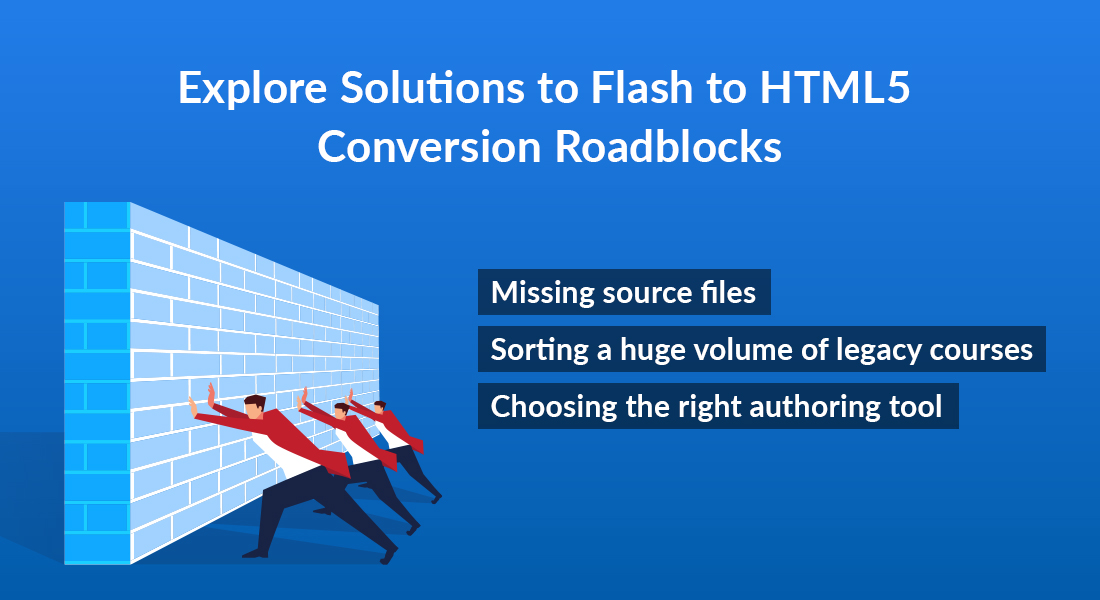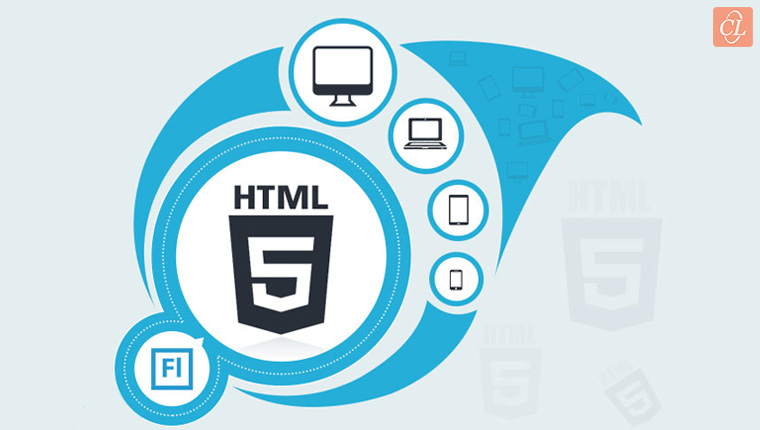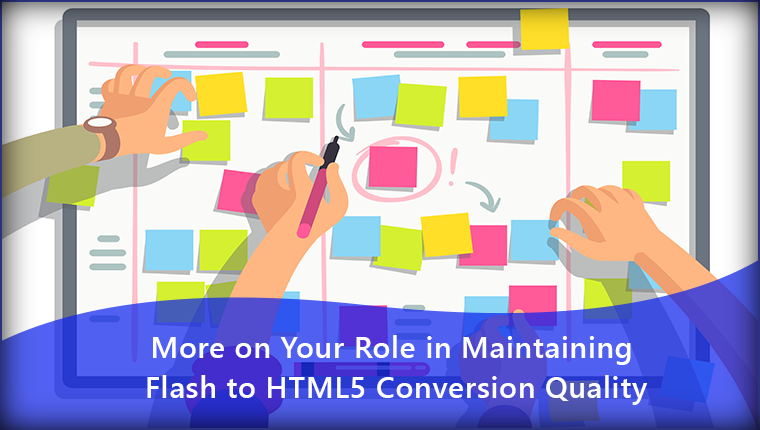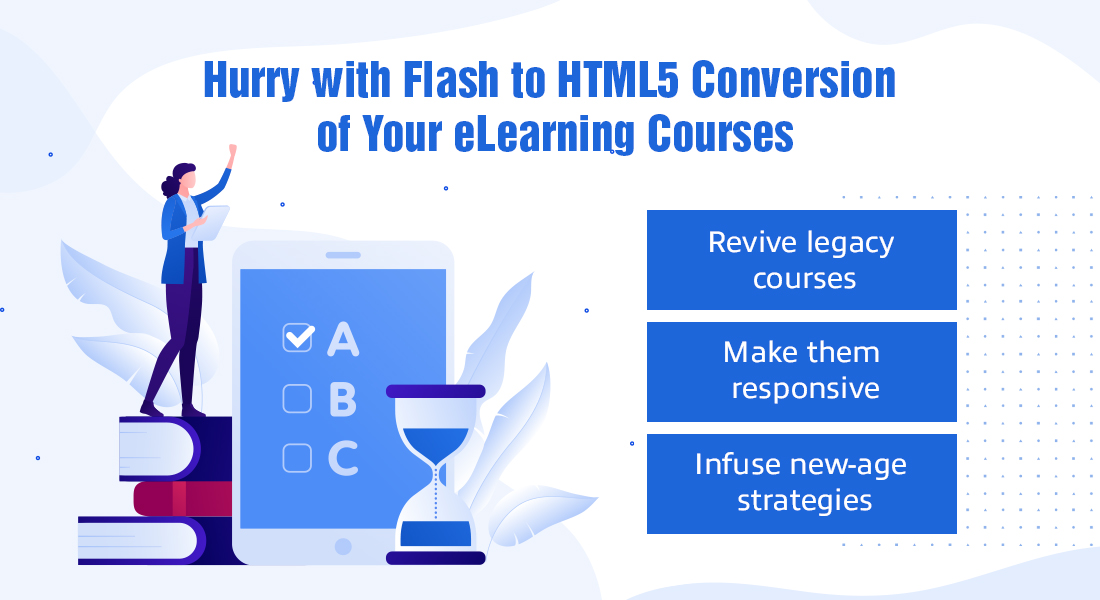5 Roadblocks in Flash to HTML5 Conversion & How to Overcome Them

2020 is all set to witness the end of the Flash era, but are you? According to an article by Forbes, this Adobe Flash cut-off will kill millions of websites, and many more might become partially inoperable.
What are the challenges in Flash to HTML5 conversion?
- Sorting legacy courses that need to be converted
- Choosing the right authoring tool
- Converting courses when source files are unavailable
- Finding the right eLearning vendor to assist you
- Working on a tight schedule
If your eLearning programs had started out by using Adobe Flash like so many others, you must be wondering what to do about this situation. “No need to worry, simply go for Flash to HTML5 conversion,” many might say.
However, in reality, it may not be so simple as there are a number of factors you need to consider. The different needs your courses cater to, the different kinds of courses you already have, and the scale of conversion, are all very unique to each organization. And due to this very reason, it’s quite common that a number of roadblocks crop up during the conversion process.
In this article we will look at the most common problems encountered during Flash to HTML5 conversion and how you can overcome them.
What you Might Encounter During Flash to HTML5 Conversion
1. Sorting Legacy Courses that Need to be Converted
When you have a large number of courses developed over the years, your first problem would be to identify all the viable courses that need to be converted from Flash to HTML5. This problem can be sorted if you follow these steps:
Step 1: Find out which of the courses are Flash-based. Files having a fla or .swf extension are what you must look out for. Now from among these, sort the ones that are viable for conversion.
Step 2: Check if the content is up-to-date. If the courses are really old and have become obsolete, there’s no point in wasting resources on converting these to HTML5. Now may be the time to decide whether each course can be updated or needs to be replaced with something new and more aligned with your current business requirements.
Step 3: Rank these courses according to urgency and store them separately. As you only have a few more months until Flash ceases to function, this will help you go about your conversion in an orderly manner.
Read this blog on the project management involved in Flash to HTML5 conversion.
2. Choosing the Right Authoring Tool
Is there a PERFECT authoring tool for all your needs? That’s a trick question. The training needs of every organization are different, so what’s perfect for someone else may not work for you at all. That is why choosing the right authoring tool for your Flash to HTML5 conversion may turn out to be yet another roadblock.
Here are a couple of strategies you can use while choosing authoring tools:
- If your existing courses are heavy on Flash interactivities, you may want to think about Storyline 360 That is because it offers a great many alternatives for the interactivities that cannot be converted directly.
- If the courses are low on animations and heavy on text, you might consider Lectora which can provide scroll bars for the text on the same slide.
3. Converting Courses without Source Files
Your organization may possess many courses that were developed expending a lot of time, effort, and money. However, overtime, their source files may have been misplaced or corrupted or unavailable due to a number of reasons. That does not mean all these courses should go to waste during the HTML5 conversion!
The easiest way to convert legacy courses would be to use a simple screen recorder. Use a recording software to convert Flash to video (MP4) only if:
- Quality of animations is rich
- It does not involve extensive user interaction
4. Finding the Right eLearning Vendor to Help You
Given the urgency with which you now have to act to convert your Flash-based courses to HTML5, it’s a good idea to find a reliable outsourcing partner proficient at handling this task. Finding the right vendor for Flash to HTML5 conversion among the many options available in this highly competitive area may be quite challenging.
So, here are a few pointers on what you must focus on when you talk to potential candidates.
- Enquire about the volume of conversion they can handle, as this must be the first criteria for you right now. If you have a large number of Flash-based courses to convert to HTML5 by the end of the year, your vendor must be up to the task.
- Discuss the new value-added services you can get with the conversion. Though Flash to HTML5 conversion is the main agenda, this need not stop you from taking advantage of services such as content updates, mobile-friendly course development, or eLearning translations.
- Clarify your expectations on the turnaround time and costs involved right at the start. With everyone going for Flash to HTML5 conversion this year, most of the best vendors must be swamped. By being very clear on your expectations, you can ensure your expectations are met. (This could be updating the instructional design.)
5. Working on a Tight Schedule
2020 is going to end in just a few months and the thought of getting your conversions done within that short time may seem impossible. You can get through this roadblock by fixing a timeline with your vendor by breaking the Flash to HTML5 conversion process into manageable chunks.
- The best way to do this is to employ an agile design and development methodology. This promotes iterative cycles of development and testing which will give greater leeway for responding to changes without compromising on speed or quality.
- For this methodology to work, you must adhere to the timeline by providing all relevant material, reviewing the process at each milestone, and resolving issues through collaboration.
- Put in place timely and efficient quality checks to check for consistency, expected functionality, accuracy of content, and adherence to branding guidelines. This can be done through online review tools for reviewing the conversion process as well as to provide timely feedback.
Act Now
So what are you waiting for? The clock is ticking and it’s time to get your Flash to HTML5 conversion done. We’ve talked about most common roadblocks that may crop up when you get started and how to overcome them. So, keep these in mind and you’ll be able to handle and avoid unnecessary delays and problems in your transition.
Want to get your hands on some checklists and action plans to further smoothen your Flash to HTML5 conversion? Find all these and more in our handy eBook that you can download for free!





